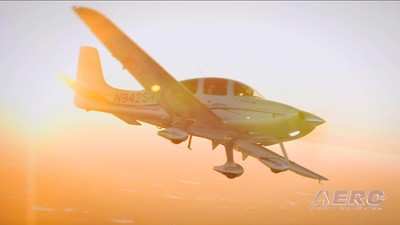SR22 Went Down On Approach Following Near Collision With
Traffic
An accident on December 15th involving two airplanes in the
traffic pattern at Scottsdale Airport (KSDL) in Arizona points to
the importance of the concept of "see and avoid." While there was
no mid-air collision, the pilot of an SR22 who was fatally injured
when his plane went down reported being unable to see a Gulfstream
on final approach because the sun was in his eyes. A passenger on
board the Cirrus (similar airplane pictured) was seriously
injured, but able to escape the wreckage of the airplane.
File Photo

NTSB Identification: WPR12FA067
14 CFR Part 91: General Aviation
Accident occurred Thursday, December 15, 2011 in Phoenix, AZ
Aircraft: CIRRUS DESIGN CORP. SR22, registration: N7850P
Injuries: 1 Fatal,1 Serious.
This is preliminary information, subject to change, and may
contain errors.
On December 15, 2011, about 0954 mountain standard time, a
Cirrus Design Corp. SR22, N7850P, experienced a loss of control and
descended into a residential neighborhood in Phoenix, Arizona. At
the time, the airplane was on short final approach for landing at
Scottsdale Airport (SDL). The airplane was registered to Frank M.
Smith & Associates, Inc., and it was operated by a company
private pilot who was fatally injured. The passenger was seriously
injured. The airplane was consumed by a post impact fire. No one on
the ground was injured during the impact sequence. The flight was
performed under the provisions of 14 Code of Federal Regulations
Part 91. Visual meteorological conditions prevailed, and no flight
plan was filed. The flight originated from Show Low, Arizona,
within minutes of 0857.
Safety Board investigators reviewed Federal Aviation
Administration (FAA) radar data and voice tapes. They indicate that
the Cirrus had entered SDL’s left-hand traffic pattern for
runway 3 from the north. The FAA SDL’s local air traffic
controller sequenced the Cirrus to land behind a Gulfstream
Aerospace GV-SP (G550), which was ahead of the Cirrus. The
Gulfstream had entered the left traffic pattern directly into the
base leg. The local controller advised the Cirrus pilot to report
when he had the Gulfstream in sight. The Cirrus pilot reported that
the sun was in his eyes, and he did not report seeing the
Gulfstream. Seconds later, the controller advised the Cirrus pilot
that the Gulfstream was to his left and on final approach, and the
Cirrus turned onto the base leg. Subsequently, as the Cirrus was
entering the final approach leg and was about 1,900 feet (based
upon the airplane’s Mode C transponder altitude), the
Gulfstream overflew the Cirrus about 2,100 feet (Mode C transponder
altitude).

The passenger in the Cirrus reported to the Safety Board
investigator that immediately thereafter the pilot observed the
Gulfstream, and he so informed the controller while continuing
toward the runway. Then the controller advised the Cirrus pilot to
standby for a possible go-around. Less than 1 minute later the
Cirrus rolled into a steep bank and descended in a corkscrew-like
maneuver into the ground, according to a ground-based witness who
was monitoring the controller’s communications and watching
the airplane.
The Safety Board investigation revealed that the airplane
impacted the ground in a right wing, nose low attitude, on about a
275-degree magnetic heading. The airplane came to rest
approximately 0.9 miles from the landing threshold of SDL’s
runway 3. The accident site elevation is about 1,420 feet mean sea
level (msl). SDL’s elevation is 1,510 feet msl.
The airplane has been recovered from the front yard of the
private residence and examined. Fire-damaged components (primary
flight and multifunction electronic displays) that contain
non-volatile memory were removed from the instrument panel. These
components have been delivered to the Safety Board’s Vehicle
Recorder Division in Washington, D.C., where an examination is in
progress.
 Airbus Racer Helicopter Demonstrator First Flight Part of Clean Sky 2 Initiative
Airbus Racer Helicopter Demonstrator First Flight Part of Clean Sky 2 Initiative Diamond's Electric DA40 Finds Fans at Dübendorf
Diamond's Electric DA40 Finds Fans at Dübendorf ANN's Daily Aero-Term (04.23.24): Line Up And Wait (LUAW)
ANN's Daily Aero-Term (04.23.24): Line Up And Wait (LUAW) NTSB Final Report: Extra Flugzeugbau GMBH EA300/L
NTSB Final Report: Extra Flugzeugbau GMBH EA300/L Classic Aero-TV: 'Never Give Up' - Advice From Two of FedEx's Female Captains
Classic Aero-TV: 'Never Give Up' - Advice From Two of FedEx's Female Captains




